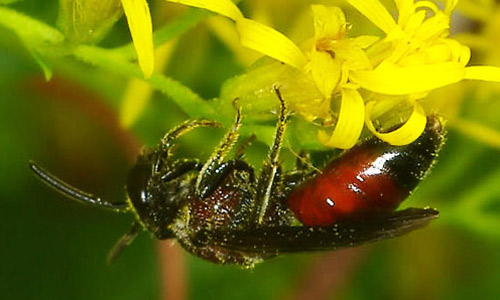common name: sweat bees, halictid bees
scientific name: Halictidae (Insecta: Hymenoptera: Halictidae)
Introduction - Distribution - Description - Biology - Nesting Behavior - Cleptoparasites - Management - Selected References
Introduction (Back to Top)
Halictidae are one of the six bee families in the order Hymenoptera. Also known as sweat bees, halictids are a very diverse group of metallic and non-metallic bees. They typically are more abundant than most bees with the exception of Apis (honey bee) species. Halictids display the most diverse gradation in social behavior (Michener 2007) as species can be solitary, communal, semi-social or eusocial. Some species exhibit solitary or eusocial behavior depending on time of year, geographic location, altitude and often unknown factors (Michener 2007). The genus Lasioglossum (=Dialictus) in Halictidae is one of the largest genera of bees worldwide, with an incredibly diverse array of behaviors.
Figure 1. Adult Lasioglossum nymphale Smith, a sweat bee, gathering pollen and nectar on goldenrod. Photograph taken in Highlands County, Florida. Photograph by Tim Lethbridge.
Figure 2. Adult Halictus poeyi Lepeletier, a sweat bee, gathering pollen on lanceleaf coreopsis, Coreopsis lanceolata. Photograph by Katie Buckley, University of Florida.
Distribution (Back to Top)
Halictid bees are found worldwide, but are especially abundant in temperate regions. Halictidae is split into four subfamilies: Rophitinae, Nomiinae, Nomioidinae and Halictinae. In Florida, there are 44 species found within eight genera. These genera include: Sphecodes (10 spp. of parastic bees), Lasioglossum (17 spp.), Nomia (4 spp.), Agapostemon (2 spp.), Augochloropsis (3 spp.), Augochlora (1 sp.), Augochlorella (3 spp.) and Halictus (4 spp.) (Pascarella 2006). Most of these species are also common throughout the eastern United States. Undoubtedly numerous other species of Lasioglossum and potentially other halictid species are also found in Florida (http://www.discoverlife.org/mp/20q?search=Apoidea#Identification).
Description (Back to Top)
Halictid bees can vary greatly in appearance. While a select few are robust, most are slender bees. The majority of species are dull to metallic black, with the remaining species being metallic green, blue or purple. Female halictids carry pollen on the tibia and femur of their hind legs, except for parasitic species (e.g. Sphecodes) which do not carry pollen at all. Males usually resemble females of the same species except that they are often more slender, do not have scopa (area of long dense hairs on hind tibia used for carrying pollen) and sometimes have a yellow clypeus (sclerite below the antennae on the bee's face). Mature larvae are grub-like in appearance, without setae, and usually less than 15 mm long. Pupae are very delicate and rarely encountered due to their brief developmental period (Michener 2007).
Figure 3. Adult Agapostemon splendens (Lepeletier), a sweat bee. Photograph by Jeff Hollenbeck.
Figure 4. Adult Halictus poeyi Lepeletier, a sweat bee, collecting pollen on Spanish needle, in Highlands County, Florida. Photograph by Tim Lethbridge.
This family of bees can be separated from other families of bees by a strongly curved basal vein in the wing. The genus Lasioglossum can be further separated by weak or reduced wing veins.
Figure 5. Example of halictid wing venation. Arrow points to strongly curved basal vein which separates sweat bees from other families of bees. Photograph by Katie Buckley, University of Florida.
Figure 6. Example of halictid (sweat bee) wing venation in Lasioglossum, showing weak or reduced wing veins. Photograph by Katie Buckley, University of Florida.
Biology (Back to Top)
In general, many bee species overwinter as prepupae. Some halictids do the same, including females of the subfamily Rophitinae. In Nomioidinae, both sexes overwinter. Halictinae and Nomiinae overwinter as mated adult females (Michener 2007, Wcislo & Engel 1996). In the spring or summer, the females emerge, mate if they have not already done so, and begin digging nests and provisioning cells with pollen and nectar. In each cell they lay a single egg. When the larva emerges from the egg, it consumes the pollen provision until the food is gone. The larva then defecates, and may or may not remain in this prepupal form that year depending on the species, season or other unknown factors. It is believed that some prepupae remain so for a year or more as a fallback for years of drought. Some prepupae, on the other hand, will pupate immediately and emerge as adults. Some of these adults also may remain in their cell over the winter, again depending on the species.
Figure 7. Augochlora pura adult standing next to a broken larval cell. The yellow pollen balls lining the cell are created by the female before she deposits the eggs. These provisions then sustain the developing larva until pupation and emergence as an adult. Photograph by Beatriz Moisset.
Most species are polylectic, or gather floral resources from multiple plant species. There are a few oligolectic species and subgenera that feed from a single plant family. Adult halictids eat nectar, and collect nectar and pollen for the larvae. All halictids are mass provisioners, that is, the adults provision each cell with all the food (pollen and nectar) a larva will need until it emerges.
Figure 8. Lasioglossum sp. consuming nectar or water. Photograph taken in Pierce County, Washington. Photograph by Lynette Schimming.
Nesting Behavior (Back to Top)
Most halictids nest underground. Nests that are built in rotting wood usually resemble ground nests (Eickwort & Eickwort 1973). Species that are parasites of other bees do not build nests at all. Despite usually nesting in the ground, nesting behavior is otherwise highly variable between the species. Each subfamily has its own characteristic nesting habit:
- In Rophitinae, larval cells typically are excavated either at a slant or horizontally off of a main lateral tunnel.
- Nomiinae build vertical cells, sometimes in clusters.
- Nomioidinae nest in sub-horizontal cells off of vertical burrows.
- Halictinae have diverse nest types, including series of cells, scattered cells and clusters of cells. The area around the clusters sometimes is excavated. Cells usually are lined with a waxy substance likely extruded from the bee's Dufour's gland (a gland found on the underside of the abdomen). Nest architecture of halictids that nest in rotting rood is irregular, usually due to the nature of the wood.
Figure 9. Adult Halictus scabiosae Rossi, a sweat bee, entering her nest. Photograph taken in Genova, Italy. Photograph by Ettore Balocchi.
Figure 10. Typical nest entrance for Augochlorini, a tribe (group of genera in a subfamily) of sweat bees. Photograph by Katie Buckley, University of Florida.
Cleptoparasites (Back to Top)
The family Halictidae contains a few social parasites and cleptoparasitic bee genera. These include Sphecodes, Microsphecodes (not present in Florida) and some Lasioglossum species. These genera are primarily cleptoparasites of other halictids or bees of similar size. Sphecodes females typically kill the egg or larva in the cell before they lay an egg, but in most other cleptoparasitic species, eggs are laid on unfinished cell walls or through sealed cells and the larva of the cleptoparasite kills the other egg or larva before eating the host's stored food (Michener 2007).
Figure 11. Adult Sphecodes heraclei Cockerell, a parasitic sweat bee, feeding on a flower. Photograph taken in Highlands County, Florida. Photograph by Tim Lethbridge.
Management (Back to Top)
Sweat bees are very important pollinators for many wildflowers and crops, including stone fruits, pomme fruits, alfalfa and sunflower. Sweat bee populations can be encouraged with wildflower plantings and by providing nesting areas. Halictids typically nest in bare soil located in a sunny location. Minimum tillage and insecticide use will help to increase populations of Halictidae and other soil nesting bees.
Figure 12. Wildflowers with exposed soil for nesting, a typical habitat for sweat bees. Photograph taken in Highlands County, Florida. Photograph by Tim Lethbridge.
Selected References (Back to Top)
- Eickwort GC, Eickwort KR. 1973. Notes on the nests of three wood-dwelling species of Augochlora from Costa Rica (Hymenoptera: Halictidae). Journal of the Kansas Entomological Society 46: 17-22.
- Michener CD. 1994. pp. 134-141. The Bee Genera of North and Central America (Hymenoptera: Apoidea). Smithsonian Institution Press, Washington DC. 304 pp.
- Michener CD. 2007. pp. 6-11, 23-29, 57-58, 319-412. The Bees of the World, 2nd Edition. The John Hopkins University Press, Baltimore, MD. 952 pp.
- Pascarella JB. (September 2008). The Bees of Florida. Department of Biology, Georgia Southern University. (no longer available online)
- Stehr FW. 1987. pp. 691-693. Immature Insects, Vol 1. Kendall/Hunt Publishing Company, Dubuque, IA. 754 pp.
- Wcislo WT, Engel MS. 1996. Social behavior and nest architecture of Nomiine Bees (Hymenoptera: Halictidae; Nomiinae). Journal of the Kansas Entomological Society 69: 158-167.






